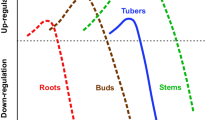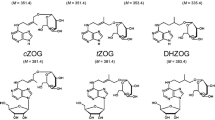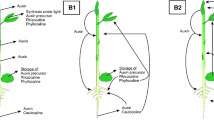Abstract
The role of endogenous ethylene in auxin-mediated tuber sprout growth inhibition was determined in potato (Solanum tuberosum L. cv. Russet Burbank) minitubers. Treatment of tubers with biologically active auxins resulted in a transient, dose-dependent increase in ethylene production and inhibition of sprout growth. Biologically inactive auxin analogs elicited neither response. Continuous exposure to > 0.001 μL L-1 exogenous ethylene inhibited sprout growth in a dose-dependent manner with complete inhibition occurring at ethylene concentrations ≥1 μL L-1. In further studies with the active auxin α-naphthalene acetic acid (NAA), the role of ethylene in auxin-induced sprout growth inhibition was determined using ethylene biosynthesis and action inhibitors. The ethylene biosynthesis inhibitor aminoethoxyvinylglycine reduced NAA-induced ethylene biosynthesis by over 80% but had no effect on sprout growth inhibition. The non-competitive ethylene action inhibitor silver thiosulfate had no effect on NAA-induced sprout growth inhibition. Similarly, both the competitive ethylene action inhibitor 2,5-norbornadiene and the irreversible action inhibitor 1-methylcyclopropene were ineffective in reducing NAA-mediated sprout growth inhibition. Collectively, these results do not support the proposal that, in the case of potato tuber sprouts, auxininduced growth inhibition is mediated by endogenous ethylene action.
Resumen
El rol del etileno endógeno en la inhibición del crecimiento del brote mediado por auxinas fue determinado en minitubérculos de papa (Solanum tuberosum L. cv. Russet Burbank). El tratamiento de tubérculos con auxinas biológicamente activas resultó en un incremento pasajero en la producción de etileno e inhibición de crecimiento del brote dependiente de la dosis. Análogos de enzimas biológicamente activas no produjeron ninguna respuesta. La contínua exposicion de etileno exógeno a una concentración > de 0.001 μL L-1 inhibió el crecimiento de brotes de mariera dependiente de la dosis, con una inhibición completa con concentraciones de etileno > a 1μL L-1. En estudios adicionales con la auxina activa α-naftaleno ácido acético (NAA), se determinó el rol del etileno en la inhibición de crecimiento del brote inducido por auxinas utilizando inhibidores de biosintesis y de accién del etileno. La aminoetoxivinilglicina, inhibidor de la biosíntesis de etileno, inducida por NAA redujo la biosíntesis de etileno en más del 80%, pero no tuvo efecto sobre la inhibición de crecimiento del brote. La acción no competitiva del tiosulfato de plata, inhibidor del etileno no tuvo efecto en la inhibición de crecimiento del brote inducida por NAA. De la misma mariera, tanto la acción competitiva del 2,5-nor-bordarieno, inhibidor del etileno, como la acción irreversible del inhibidor 1-metilcloropeno no fueron efectivos para reducir la inhibición de crecimiento del brote por mediación del NAA. Colectivamente estos resultados no apoyan la opinion de que la inhibición de crecimiento de los brotes de papa inducida por auxinas sea realizada por mediación del etileno endógeno.
Similar content being viewed by others
Abbreviations
- ABA:
-
Abscisic acid
- AVG:
-
aminoethoxyvinylglycine
- BNZ:
-
benazolin
- 2,4-D:
-
2,4-dichlorophenoxyacetic acid
- 2,6-D:
-
2,6-dichlorophenoxyacetic acid
- DMSO:
-
dimethylsulfoxide
- IAA:
-
indole-3-acetic acid
- MCP:
-
1-methylcyclopropene
- NAA:
-
a-naphthalene acetic acid
- 2-NAA:
-
2-naphthalene acetic acid
- NBD:
-
2,5-norbornadiene
- PAA:
-
phenylacetic acid
- STS:
-
silver thiosulfate
Literature Cited
Abeles FB, PW Morgan, and ME Saltveit. 1992. Ethylene in Plant Biology. Academic Press, New York.
Bergenstråhle A, E Tillberg, and L Jonsson. 1993. Effects of ethephon and norbornadiene on sterol and glycoalkaloid biosynthesis in potato tuber discs. Physiol Plant 89:301–308.
Boiler T, RE Herner, and H Kende. 1979. Assay for and enzymatic formation of an ethylene precursor, 1-aminocyclopropane-l-carboxylic acid. Planta 145:293–303.
Ciardi J, and H Klee. 2001. Regulation of ethylene-mediated responses at the level of the receptor. Ann Bot 88:813–822.
Cvikrová M, LS Sukhova, J Eder, and NP Korableva. 1994. Possible involvement of abscisic acid, ethylene and phenolic acids in potato tuber dormancy. Plant Physiol Biochem 32:685–691.
deBruxelles GL, and MR Roberts. 2001. Signals regulating multiple responses to wounding and herbivores. Crit Rev Plant Sci 487–521.
Denny FE. 1945. Further tests of the use of the methylester of alphanaphthalene acetic acid for inhibiting the sprouting of potato tubers. Contr Boyce Thompson Inst 14:15–20.
Filmer AAE, and MJC Rhodes. 1985. Investigation of sprout-growthinhibitory compounds in the volatile fraction of potato tubers. Potato Res 28:361–377.
Hansen H, and K Grossmann. 2000. Auxin-induced ethylene triggers abscisic acid biosynthesis and growth inhibition. Plant Physiol 124:1437–1448.
Grossmann K. 2000. Mode of action of auxin herbicides: a new ending to a long drawn out story. Trends in Plant Sci 5:506–508.
Gude H, and LHW van der Plaas. 1985. Endogenous ethylene formation and the development of the alternative pathway in potato tuber discs. Physiol Plant 65:57–62.
Guthrie JD. 1940. Control of bud growth and initiation of roots at the cut surface of potato tubers with growth-regulating substances. Contr Boyce Thompson Inst 11:29–53.
Lewis MD, GE Kleinkopf, and KK Shetty. 1997. Dimethylnaphthalene and diisopropylnaphthalene for potato sprout control in storage: 1. Application methodology and efficacy. Am Potato J 74:183–197.
Poapst PA, AB Durkee, WA McGugan, and FB Johnston. 1968. Identification of ethylene in gibberellic-acid-treated potatoes. J Sci Food Agric 19:325–327.
Prange RK, W Kalt, BJ Daniels-Lake, CL Liew, and RT Page. 1998. Using ethylene as a sprout control agent in stored Russet Burbank potatoes. J Amer Soc Hort Sci 123:463–469.
Prange RK, W Kalt, BJ Daniels-Lake, CL Liew, J Walsh, P Dean, R Coffin, and RT Page. 1997. Alternatives to currently used potato sprout suppressants. Postharvest News & Info 8:37N-41N.
Rylski I, L Rappaport, and HK Pratt. 1974. Dual effects of ethylene on potato dormancy and sprout growth. Plant Physiol 53:658–662.
Sisler EC, and M Serek. 1996. Methods of counteracting an ethylene response in plants. USA Patent No. 5,518,988.
Sisler EC, and M Serek. 1997. Inhibitors of ethylene responses in plants at the receptor level: recent developments. Physiol Plant 100:577–582.
Sterling TM, and JC Hall. 1997. Mechanism of action of natural auxins and the auxinic herbicides. In: RM Roe (ed), Herbicide Activity: Toxicology, Biochemistry and Molecular Biology. IOS Press, Amsterdam, pp. 111–141.
Suttle JC. 1998. Involvement of ethylene in potato microtuber dormancy. Plant Physiol 118:843–848.
Valenzuela-Valenzuela JM, NK Lownds, and TM Sterling. 2002. Ethylene is not involved in clopyralid action in yellow starthistle (Centaurea solstitialis L.). Pesticide Biochem Physiol 72:142–152.
Veen H. 1983. Use of inhibitors of ethylene action. Acta Hort 201:213–222.
Wei YD, HG Zheng, and JC Hall. 2000. Role of auxinic herbicide-induced ethylene on hypocotyl elongation and root/hypocotyl radial expansion. Pest Management Sci 56:377–387.
Author information
Authors and Affiliations
Rights and permissions
About this article
Cite this article
Suttle, J.C. Auxin-induced sprout growth inhibition: Role of endogenous ethylene. Am. J. Pot Res 80, 303–309 (2003). https://doi.org/10.1007/BF02854314
Accepted:
Issue Date:
DOI: https://doi.org/10.1007/BF02854314




